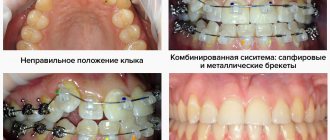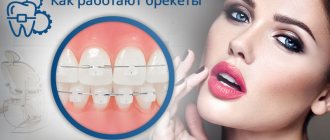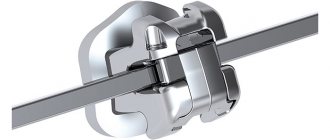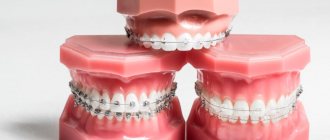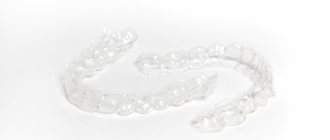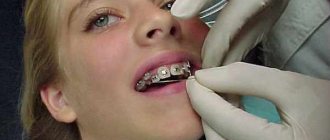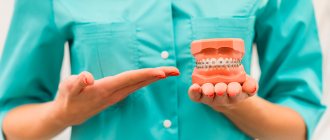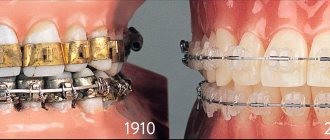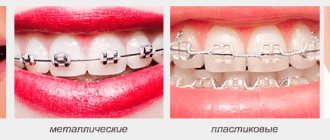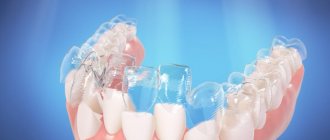Ceramic non-ligature and ligature braces are orthodontic structures that can correct uneven teeth and malocclusion. They all have different forces on the teeth, so the decision about what exactly to install is always made by the attending physician, based on the individual characteristics of the patient.
Ligature and non-ligature braces: comparison of designs
Ligature braces got their name due to the presence in the structure of the product of fastening rubber bands or steel wires - ligatures. They are responsible for the tension of the arch and the force of pressure on the teeth. In addition to ligatures, the orthodontic structure contains:
- plates (bases, brackets) – fixed on the teeth and have a small groove for installing an arch;
- arch – made of metal and passes through the grooves of the plates, combining the elements of braces into a single system.
Plates and an arc are also available in non-ligature products. But it is not the ligatures for braces that are responsible for fastening them, but the clasps - fasteners that secure the arches on the plates. An alternative name for non-ligating solutions is self-ligating, since the arch “autonomously” changes the tension force, providing the teeth with the necessary pressure and forcing them to move to the correct place in the jaw row.
The presence or absence of ligatures is the main structural difference between bracket systems. But when choosing parents, this fact is of little interest. There is a more important question: what is better for treating a child’s bite – ligature and non-ligature braces?
Rodikova Tatyana
“When choosing braces – ligature and non-ligature – the doctor first of all evaluates the potential of the design. The impact on the bite, the speed of correction and the patient’s comfort are the main selection criteria.”
How are ligature-free systems installed?
The process of fixing self-ligating non-ligature structures is no different from installing classical ligature systems.
- Before fixing the structure, a full examination of the oral cavity is carried out; sometimes, to achieve the desired result of orthodontic treatment, teeth are removed and dentures are installed. All carious lesions must be removed and professional cleaning carried out.
- Locks of the chosen design are fixed to the teeth. This happens with the help of dental glue. This is the most critical stage: incorrectly installed locks will negatively affect the duration and quality of treatment.
- If necessary, the remaining glue is removed, and the clasps are finally secured to the teeth using a lamp with ultraviolet light.
- On the side, on the chewing teeth, orthodontic rings and locks are fixed.
- All installed locks are connected to each other by means of an orthodontic arch, which is fixed in their grooves.
Installation of the system takes about one hour. But the preparatory stage may well last for several weeks or even months - it all depends on the initial condition of the patient’s oral cavity.
Self-ligating and ligature braces: what is the difference
When ligature-free products first entered the dental market, they were accompanied by aggressive marketing and confident PR from manufacturers. This increased sales, but some exaggeration of the benefits made the professional audience and interested clients skeptical. For a long time there were debates about quality, efficiency and convenience. Research was carried out. The bottom line is that the analysis showed which of the advantages of self-ligating braces are true and which are fiction.
Ligature and non-ligature braces - similarities and differences:
Stages of corrective therapy
Correcting anomalies of the dental system is a long and painstaking process consisting of several stages:
- visual and hardware diagnostics: computed tomography, teleradiography,
- rendering a verdict, making a diagnosis, determining indications and contraindications;
- development of a treatment plan;
- oral hygiene: treatment of teeth and gums, professional cleaning;
- taking individual measurements (casts or scanning), making a model, drawing up an estimate;
- production of braces;
- installation of a brace system for a patient;
- wearing the device with periodic system adjustments. The duration depends on the severity of the specific clinical case and is determined by the orthodontist;
- removal of braces and installation of a removable or non-removable retainer. The duration of retention also depends on the individual characteristics of the clinical case.
Specialist comment: the retention stage is very important for consolidating the achieved results. Failure to follow the recommendations of the attending orthodontist may invalidate the results of therapy, and everything will return to its previous position.
Tooth extraction.
The decision to free up additional space for teeth when correcting the bite is made by the dentist. If extraction of healthy teeth is unavoidable, then regardless of the type of braces installed, it will be necessary to visit a surgeon.
Plaksina Margarita
“Teeth preservation is the priority of our dentistry. But in rare cases, removal cannot be avoided. And the type of braces does not matter here. If there is no space for the correct positioning of teeth, it has to be created artificially.”
- Care.
It is easier to clean self-ligating structures, since there are no bulky fasteners that accumulate food debris and complicate the procedure.
- Comfortable to wear.
Plates with ligatures are flatter, but the elastic bands or wire fastenings themselves cause some discomfort. Self-ligating ones are more streamlined, but are about 1 mm thicker. Both options take some getting used to.
- Frequency of visits.
Elastic ligatures stretch and tear - they need to be changed every month. Correction of self-ligating systems is carried out less frequently; the patient comes for an appointment every 1.5-2 months.
Dolotova Marina
“Our orthodontists often invite patients monthly, alternating correction of the upper and lower jaw. This is convenient for the patients themselves – less discomfort, more pleasant treatment.”
- Aesthetics.
The main attention in braces is not the rubber bands and wire, but the base material. He is responsible for the decorativeness and invisibility of braces.
How to care for braces?
Regardless of the type of braces used, ligature or non-ligature, they require careful care. It should be noted that you cannot limit yourself to brushing your teeth in the morning and evening. Due to the fact that braces have protrusions and different methods of fastening, cleaning out food debris becomes problematic.
According to the doctor's recommendations, you will need to purchase a special dental solution, a large brush, a small brush and dental floss from the pharmacy. Oral hygiene will have to be done after every meal. First of all, you need to use a large brush that will remove large food debris from the tooth surface. Then you can move on to a fine brush. Using such a hygienic tool, you can remove germs in hard-to-reach places. The final stage is using dental floss. Only after such manipulations can oral hygiene be completed. One procedure takes on average 10-15 minutes after each meal. On average, it will take 30-40 minutes a day to clean your braces and mouth from bacteria.
Please note: braces can only be installed on completely healthy teeth. If treatment is required for periodontitis or other diseases of the teeth and gums, these problems are first eliminated, and only then the system is installed.
Sincerely, Levin D.V., chief physician
Materials and types of bracket systems
Corrective dental appliances are made from different materials. The base determines the attractiveness of products and is responsible for strength characteristics and durability. Main braces options:
- Metal.
Noticeable on the teeth, but with many other advantages. Among the advantages of metal are strength, affordability, and elimination of the most serious pathologies. In addition to low attractiveness, the disadvantages include a high degree of injury, but manufacturers are gradually eliminating this defect, making the designs more streamlined and miniature. Doctors install metal non-ligature and ligature braces systems.
- Sapphire.
Less durable, but almost invisible on the teeth. The transparency of artificial sapphire allows the plates to merge with the enamel. The effectiveness of treatment is high. Execution of products - in both versions.
- Ceramic.
When choosing white ceramics, high aesthetics are guaranteed. Strength is lower than sapphires and metal, reliability is also lower. The plates are characterized by increased fragility, which requires the correct selection of menus during the treatment period. Ceramic braces can be non-ligature and ligature braces.
- Plastic.
Suitable for simple correction and elimination of small bite defects. Strength and reliability are low. Dietary requirements – no solids or pigmented foods or drinks. More often used in a ligature version.
The products also differ in the technology of attachment to teeth:
- Vestibular.
The base is attached to the outer (vestibular) surface of the tooth.
- Lingual.
The plates are fixed on the inner (lingual) side of the crown. They are invisible to others - invisible braces.
Lingual ones are made to order, since the base must duplicate the anatomical shape of the teeth.
Flaws:
- gradually lose elasticity and require replacement of component elements;
- act slowly: teeth, moving, are forced to overcome friction;
- may lead to discomfort due to the fixed fixation of the arch;
- bulky design requires complex maintenance;
- food coloring can stain rubber bands;
- cannot be used for periodontal disease and periodontitis;
- the need for monthly visits to the doctor.
Rice. 1 Ligature braces
How to choose braces for a child: self-ligating or ligature
The main criterion for choosing a brace system is the doctor’s recommendations. The orthodontist will look at the young patient’s photographs, make calculations for correction, and conduct 3D modeling. And based on the work done, he will offer options for braces systems. These will be structures that will most quickly and effectively eliminate the current pathology and straighten the bite.
At this stage, children and parents get involved in the choice: evaluate ligature and non-ligature braces based on photos and samples - compare the design, discuss preferences. Some people like colored rubber bands, which the doctor changes every appointment, others want transparent strips to hide the signs of the treatment being performed. It is important to hear the child’s opinion, because wearing braces for a long time - from several months to 2 years.
The optimal option is selected in dialogue, after which the doctor makes an appointment to install a ligature or self-ligating system, and the young patient begins his path to health, beauty and charm.
Indications and contraindications for installation
Any type of treatment should be prescribed exclusively by a specialist. Therefore, identifying indications and contraindications for correcting occlusion defects is a priority step, without which corrective therapy cannot be started.
Indications:
- Incorrect position of the jaws or individual teeth
- Tremas and diastemas (large distances between dental elements)
- Crowding of dental units
- Deep or crossbite
Contraindications:
- Periodontitis and periodontal disease
- Endocrine pathologies
- Severe cardiovascular diseases
- HIV;
- Tuberculosis
- Bone diseases (osteoporosis, osteomyelitis)
- Bleeding disorder
- Edentia (absence of many teeth)
- Oncology
- Mental illness
Important: An orthodontist identifies indications for starting corrective therapy with braces only after conducting a thorough hardware diagnosis. This is necessary to develop an adequate detailed treatment plan.
What are self-ligating braces?
Ligature-free braces consist of an arch and a plate with clasps in which the arch is fixed. As in ligature systems
, self-ligating systems provide for fastening the plate to the tooth surface, but it is more compact - it occupies less area of the crown. One of the main features of non-ligature systems is that the arch is not firmly fixed - it remains mobile within the space inside the lock. Therefore, it can move following changes in the position of the teeth and exerts constant and gentler pressure. The friction force with this treatment is less. In addition, unlike rubber ligatures, the clasps of self-ligating systems do not lose their properties over time.
These differences provide greater comfort for the patient - these braces are easier to wear and easier to care for. In this case, you need to visit the orthodontist less often. If replacing ligatures and correcting the arch when wearing ligature braces requires a visit every 3-4 weeks, then when treating with a self-ligating system, visits are usually scheduled once every 6-8 weeks.
Features of the adaptation period
The patient should be prepared to experience discomfort for several days or weeks (depending on the threshold of sensitivity):
- rubbing of the mucous membranes of the lips and cheeks;
- violation of diction;
- discomfort when eating.
Expert advice for minimizing discomfort:
- to prevent chafing, you can use special wax (sold in pharmacies);
- for minor pain, you should rinse your mouth 3-4 times a day with saline solution (1 tsp per glass of warm water). The procedure cannot be performed if there are wounds and abrasions in the mouth. In this case, it is better to use a soda solution in the same concentration;
- In case of severe pain, you need to take a tablet of any painkiller. Note: strictly follow the dosage indicated in the instructions for the medicine;
- In the first days after installing braces, cancel intense physical training. Yoga exercises will help during this period;
- learn to chop food with a knife, exclude excessively hard or sticky foods (dried, dried) from your diet. During the first few days, the products can be ground in a blender.
Attention: if the pain is severe and does not go away within several days, then you should definitely consult your doctor.
Comparative characteristics
| Characteristics | Ligature braces | Self-ligating braces |
| Arc fixation method | Ligatures | Micro locks |
| Attaching braces | To the vestibular and lingual surfaces of the teeth | To the vestibular and lingual surfaces of the teeth |
| Materials | Metal, ceramics, sapphire | Metal, ceramics, sapphire |
| Correction frequency | Once a month | Manufacturers recommend once every 2-3 months |
| Painfulness of treatment | Individually | Individually |
| Duration of treatment | From 14 months to 3.5 years | According to the manufacturers - 20-30% shorter |
| Treatment effectiveness | Corrects the most complex malocclusions | Cannot cope with complex malocclusions |
| The need to remove teeth before installing the device | If the jaw is small and there is no room for 32 straight teeth, removal is inevitable. | If the jaw is small and there is no room for 32 straight teeth, removal is inevitable. |
| Price | From 9000 rubles | From 25,000 rubles |
By location on teeth
- Vestibular braces are traditional clasps on the outside of teeth. This is the most common and versatile type of braces - they are suitable for treating any malocclusion and patients of any age, starting from adolescence. External braces can be metal or aesthetic (sapphire, ceramic).
- Lingual braces are attached to the inside of the teeth. Their clasps have a flatter fixation platform, to which an arc is attached to ligatures. The Confidence clinic works with lingual braces Win and incognito, which have a similar design, are created individually for the patient and differ in alloys.
